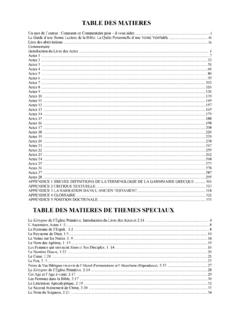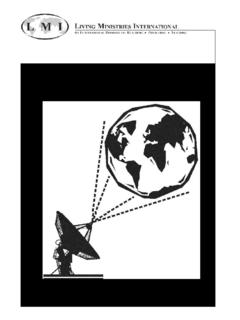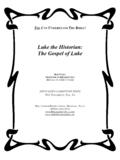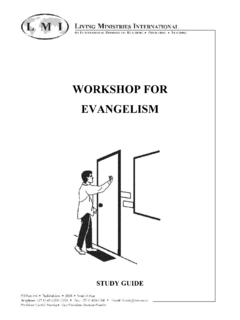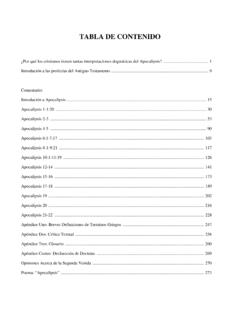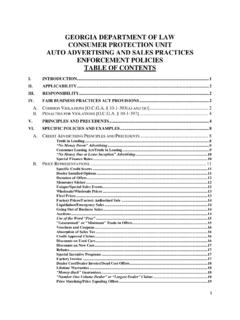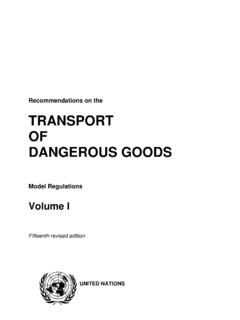Transcription of TABLE OF CONTENTS - Free Bible Commentaries …
1 TABLE OF CONTENTSD edication .. iThe New American Standard Bible iiA Word From the Author: How Can This Commentary Help You? .. iiiA Guide to Good Bible Reading: A Personal Search for Verifiable :Introduction to 2 ..20 Hebrews 3 ..32 Hebrews 4 ..44 Hebrews 5 ..53 Hebrews 6 ..59 Hebrews 7 ..70 Hebrews 8 ..79 Hebrews 9 ..85 Hebrews 10 ..99 Hebrews 11 ..113 Hebrews 12 ..123 Hebrews 13 ..135 Appendix One:Brief Definitions of Greek Grammatical Structure ..146 Appendix Two:Textual Three: Glossary ..160 Appendix Four: Doctrinal Statement ..170 SPECIAL TOPICS FOR HEBREWSThis Age And The Age To Come, 1:2 .. 8 Illumination, 1 12 Righteousness, 1:9 .. 14 Anointing in the Bible , 1 16 Greek Verb Tenses Uses for Salvation, 1 18 Sanctification, 2 26 Null and Void, (Katarge ), 2:15 .. 28 Greek Terms for Testing and their Connotations, 2 30 Confession, 3 34 The Heart, 3:8 .. 36 Apostasy (aphist mi), 3 39 Christian Assurance, 3:14.
2 42 Heavens, 4 49 The Need To Persevere, 4:14 .. 50 Does Any Believer Ever Fall Away, 6:5 .. 62 Renewed (Anakain sis), 6 64 Saints, 6 66 End or Fulfillment (Telos), 7:11 .. 73 Blameless, Innocent, Guiltless, Without Reproach, 7 76 Covenant, 8:6 .. 82 The Ark Of The Covenant, 9:4 .. 87 Ransom/Redeem, 9:15 .. 93 Repentance, 12:17 .. 130 The Kingdom Of God, 12 133 The Will (thel ma) of God, 13 142I would like to dedicate this volume to my teacher of HebrewF. B. Hueywho taught for many years atSouthwestern Baptist Theological was such a wonderful role modelin personal piety and academic s what the Lockman Foundation has to say about the New American Standard Bible 1995 Update:Easier to read:}Passages with Old English thee s and thou s etc. have been updated to modern English.}Words and phrases that could be misunderstood due to changes in their meaning during the past 20 years have been updatedto current English.
3 }Verses with difficult word order or vocabulary have been retranslated into smoother English.}Sentences beginning with And have often been retranslated for better English, in recognition of differences in style betweenthe ancient languages and modern English. The original Greek and Hebrew did not have punctuation as is found in English, andin many cases modern English punctuation serves as a substitute for And in the original. In some other cases, and is translatedby a different word such as then or but as called for by the context, when the word in the original language allows accurate than ever:}Recent research on the oldest and best Greek manuscripts of the New Testament has been reviewed, and some passages havebeen updated for even greater fidelity to the original manuscripts.}Parallel passages have been compared and reviewed.}Verbs that have a wide range of meaning have been retranslated in some passages to better account for their use in the still the NASB:}The NASB update is not a change-for-the-sake-of-change translation.
4 The original NASB stands the test of time, and changehas been kept to a minimum in recognition of the standard that has been set by the New American Standard Bible .}The NASB update continues the NASB s tradition of literal translation of the original Greek and Hebrew without in the text have been kept within the strict parameters set forth by the Lockman Foundation s Fourfold Aim.}The translators and consultants who have contributed to the NASB update are conservative Bible scholars who have doctoratesin Biblical languages, theology, or other advanced degrees. They represent a variety of denominational a tradition:The original NASB has earned the reputation of being the most accurate English Bible translation. Other translations in recentyears have sometimes made a claim to both accuracy and ease of reading, but any reader with an eye for detail eventually discoversthat these translations are consistently inconsistent.
5 While sometimes literal, they frequently resort to paraphrase of the original,often gaining little in readability and sacrificing much in terms of fidelity. Paraphrasing is not by nature a bad thing; it can andshould clarify the meaning of a passage as the translators understand and interpret. In the end, however, a paraphrase is as mucha commentary on the Bible as it is a translation. The NASB update carries on the NASB tradition of being a true Bible translation,revealing what the original manuscripts actually say not merely what the translator believes they mean. The Lockman FoundationiiiiiA WORD FROM THE AUTHOR: HOW CAN THIS COMMENTARY HELP YOU?Biblical interpretation is a rational and spiritual process that attempts to understand an ancient inspiredwriter in such a way that the message from God may be understood and applied in our spiritual process is crucial but difficult to define. It does involve a yieldedness and openness toGod.
6 There must be a hunger (1) for Him, (2) to know Him, and (3) to serve Him. This process involvesprayer, confession and the willingness for lifestyle change. The Spirit is crucial in the interpretive process,but why sincere, godly Christians understand the Bible differently, is a rational process is easier to describe. We must be consistent and fair to the text and not beinfluenced by our personal or denominational biases. We are all historically conditioned. None of us areobjective, neutral interpreters. This commentary offers a careful rational process containing threeinterpretive principles structured to help us overcome our PrincipleThe first principle is to note the historical setting in which a biblical book was written and the particularhistorical occasion for its authorship. The original author had a purpose, a message to communicate. Thetext cannot mean something to us that it never meant to the original, ancient, inspired author.
7 Hisintent not our historical, emotional, cultural, personal or denominational need is the key. Applicationis an integral partner to interpretation, but proper interpretation must always precede application. It mustbe reiterated that every biblical text has one and only one meaning. This meaning is what the originalbiblical author intended through the Spirit s leadership to communicate to his day. This one meaning mayhave many possible applications to different cultures and situations. These applications must be linked tothe central truth of the original author. For this reason, this study guide commentary is designed to providean introduction to each book of the PrincipleThe second principle is to identify the literary units. Every biblical book is a unified have no right to isolate one aspect of truth by excluding others. Therefore, we must strive tounderstand the purpose of the whole biblical book before we interpret the individual literary units.
8 Theindividual parts chapters, paragraphs, or verses cannot mean what the whole unit does not must move from a deductive approach of the whole to an inductive approach to the , this study guide commentary is designed to help the student analyze the structure of each literaryunit by paragraphs. Paragraph and chapter divisions are not inspired, but they do aid us in identifyingthought at a paragraph level not sentence, clause, phrase or word level is the key in followingthe biblical author s intended meaning. Paragraphs are based on a unified topic, often called the theme ortopical sentence. Every word, phrase, clause, and sentence in the paragraph relates somehow to this unifiedtheme. They limit it, expand it, explain it, and/or question it. A real key to proper interpretation is to followthe original author s thought on a paragraph-by-paragraph basis through the individual literary units thatmake up the biblical book.
9 This study guide commentary is designed to help the student do that bycomparing modern English translations. These translations have been selected because they employdifferent translation United Bible Society s Greek text is the revised fourth edition (UBS4). This text wasparagraphed by modern textual New King James Version (NKJV) is a word-for-word literal translation based on the Greekmanuscript tradition known as the Textus Receptus. Its paragraph divisions are longer than theother translations. These longer units help the student to see the unified New Revised Standard Version (NRSV) is a modified word-for-word translation. It forms amidpoint between the following two modern versions. Its paragraph divisions are quite helpful inidentifying Today s English Version (TEV) is a dynamic equivalent translation published by the UnitedBible Society. It attempts to translate the Bible in such a way that a modern English reader orspeaker can understand the meaning of the Greek text.
10 Often, especially in the Gospels, it dividesparagraphs by speaker rather than by subject, in the same way as the NIV. For the interpreter spurposes, this is not helpful. It is interesting to note that both the UBS4 and TEV are published bythe same entity, yet their paragraphing New Jerusalem Bible (NJB) is a dynamic equivalent translation based on a French Catholictranslation. It is very helpful in comparing the paragraphing from a European The printed text is the 1995 Updated New American Standard Bible (NASB), which is a word for word translation. The verse by verse comments follow this PrincipleThe third principle is to read the Bible in different translations in order to grasp the widest possiblerange of meaning (semantic field) that biblical words or phrases may have. Often a Greek phrase or wordcan be understood in several ways. These different translations bring out these options and help to identifyand explain the Greek manuscript variations.


